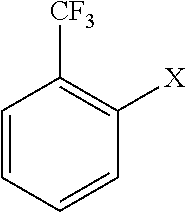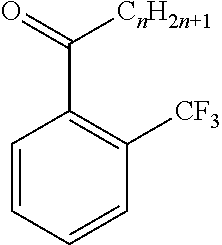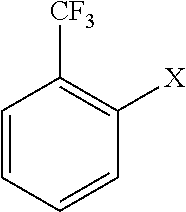Method of producing 2'-trifluoromethyl group-substituted aromatic ketone
a technology of trifluoromethyl group and aromatic ketone, which is applied in the field of producing 2′-trifluoromethyl group substituted aromatic ketone, can solve the problems of difficult separation between the 2′-trifluoromethyl-substituted aromatic ketone, the dppp ligand, and the palladium catalyst, and achieves superior production methods and efficient productivity
- Summary
- Abstract
- Description
- Claims
- Application Information
AI Technical Summary
Benefits of technology
Problems solved by technology
Method used
Image
Examples
example 1
[0042]To a 200 ml-four-necked flask with a thermometer, 75.0 g of tetrahydrofuran (1.04 mol; manufactured by Nacalai Tesque, Inc.), 5.1 g of magnesium powder (0.208 mol; manufactured by Chuo-kosan), 1.7 g of LiCl (0.04 mol; manufactured by Nacalai Tesque, Inc.) were placed and the mixture was stirred while the inside of the system was substituted with a nitrogen gas. To this, 0.5 g of 1 mol / L ethylmagnesium bromide THF solution (manufactured by Tokyo Chemical Industry Co., Ltd.) was added and water in the system was removed. Subsequently, 0.44 g of ethyl bromide (0.004 mol; manufactured by Wako Pure Chemical Industries, Ltd.) was added thereto. The mixture was stirred for a while; and the generation of heat was confirmed. Subsequently, 36.1 g of o-chlorobenzotrifluoride (0.2 mol; manufactured by Wako Pure Chemical Industries, Ltd.) was gradually added dropwise, while the temperature of the reaction solution was kept at 45 to 50° C. After the completion of the dropwise addition, the ...
example 2
[0046]A reaction was carried out in the same manner as described in Example 1 except that 36.1 g (0.2 mol) of o-chlorobenzotrifluoride was altered to 45.0 g (0.2 mol) of o-bromobenzotrifluoride in Example 1.
[0047]The obtained oil phase was analyzed by a gas chromatography method; and as a result, the yield of 2′-trifluoromethyl acetophenone reaction was 85.5% (based on the raw material, o-bromobenzotrifluoride).
example 3
[0048]A reaction was carried out in the same manner as described in Example 1 except that 30.6 g (0.3 mol) of acetic anhydride was altered to 39.0 g (0.3 mol) of propionic anhydride in Example 1. The obtained oil phase was analyzed by a gas chromatography method; and as a result, the yield of 2′-trifluoromethyl propiophenone reaction was 73.3% (based on the raw material, o-chlorobenzotrifluoride).
PUM
| Property | Measurement | Unit |
|---|---|---|
| time | aaaaa | aaaaa |
| temperature | aaaaa | aaaaa |
| temperature | aaaaa | aaaaa |
Abstract
Description
Claims
Application Information
 Login to View More
Login to View More - R&D
- Intellectual Property
- Life Sciences
- Materials
- Tech Scout
- Unparalleled Data Quality
- Higher Quality Content
- 60% Fewer Hallucinations
Browse by: Latest US Patents, China's latest patents, Technical Efficacy Thesaurus, Application Domain, Technology Topic, Popular Technical Reports.
© 2025 PatSnap. All rights reserved.Legal|Privacy policy|Modern Slavery Act Transparency Statement|Sitemap|About US| Contact US: help@patsnap.com



